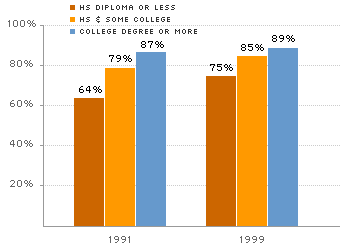Important Predictors of Early Education and Care
Note: The National Household Education Survey (NHES) differentiates between two major categories of early education and care. Preschool or center-based early education and care includes prekindergarten, day care centers, nursery schools, and Head Start. The other category, non-parental education and care, includes all types of early education and care not provided by either the mother or father. This category includes both center-based programs and home-based care, which may be offered by relatives or home-based providers.
Age of Child: As children get older, the more likely they are to be in care and education. Most 5-year olds are in kindergarten; therefore, 4-year olds have the biggest need for preschool programs.
Mother's Employment: If mothers work, their children are much more likely to need non-parental education and care. A 1997 Census Report shows about 17% of the nation's preschoolers were cared for by their father.
Differences in use of all types of education and care by mother's employment status: for 3-year olds

In 1991, 78% of employed mothers of 3-year olds used outside education and care, compared with 38% of stay-at-home mothers. In 1999, 84% of working mothers used someone other than a parent to educate and care for their 3-year olds, compared with 43% of mothers who weren't in the work force.
Differences in use of all types of education and care by mother's employment status: for 4-year olds

Employed mothers of 4-year olds are even more likely to use non-parental education and care than employed mothers of 3-year olds. In 1991, 85% of working mothers of 4-year olds used education and care programs, with that figure jumping to 91% in 1999. This increase indicates the demand for preschool programs for working mothers of 4-year olds is becoming nearly universal.
Source: Data from National Household Education Survey – A nationally representative sample of 7347 three- and four-year olds collected in 1991 and 1999. The survey looked at the employment status of the primary caretaker – 97% were mothers.
Mother's Marital Status: If a mother is single, her employment is likely to be the primary economic support for the family and she is more likely to need a source outside the family to provide education and care for young children. Single-parent families generally make much greater use of non-parental care, although differences between single-and two-parent households in preschool enrollment are small.
Mother's Education: College-educated mothers are more likely to enroll their 3- and 4-year olds in education and care programs. And the impact of higher education on the use of preschool programs is even greater.
Enrollment of 3-year olds in all types of education and care based on mother's education

In 1991, 82% of mothers with at least a college degree used non-parental education and care for their 3-year olds, compared with 49% of mothers who had a high school diploma or less. That gap shrunk in 1999, with 58% of mothers with a high school diploma or less using any type of education and care, compared with 80% of the highly-educated mothers.
Preschool Enrollment of 3-year olds based on mother's education

Throughout the 90s, highly-educated mothers were roughly twice as likely to use preschool programs for their 3-year olds as were mothers who had a high school diploma or less.
Enrollment of 4-year olds in all types of education and care based on mother's education

In 1991, 87% of mothers with at least a college degree enrolled their 4-year olds in education and care programs, compared with 64% of mothers who had a high school diploma or less. That gap shrunk in 1999, with 89% of highly-educated mothers using non-parental care, compared with 75% of mothers with a high school diploma or less.
Preschool Enrollment of 4-year olds based on mother's education

In 1991, 80% of highly-educated mothers enrolled their 4-year olds in preschool programs, compared with 48% of mothers who had a high school diploma or less. That difference declined in 1999, as the percentage of highly-educated mothers enrolling their 4-year olds in preschool stayed at 80, while the percentage of mothers with a high school diploma or less using center-based care jumped to 59.
Source: Data from National Household Education Survey – A nationally representative sample of 7601 three- and four-year olds collected in 1991 and 1999.
Income: Preschool participation generally increases along with the mother's income. The exception, however, is that families in poverty have somewhat higher participation rates than families just above the poverty line, who do not qualify for as much public support.
Projected Trends and Suggested Areas for Research
The U.S. Census Bureau predicts the number of 3- and 4-year olds will be fairly stable over the next decade. Therefore, we can expect growing demand for preschool programs, since it's likely the trends toward more working women and higher education and income levels will continue. In addition, Congress is considering welfare reform legislation that would require recipients to work more hours, increasing the need for education and care.
As the demand for early education and care grows, researchers will need to examine:
- The demographics that are likely to change.
- The effects of demographic change on early education and care, particularly those related to immigration.
- Regional differences not explained by demographics.
- The effects of policy changes in state prekindergarten programs, Head Start, kindergarten, welfare reform, and other education and care programs.
Fact sheet published by National Institute for Early Education Research, Rutgers, The State University of New Jersey.



